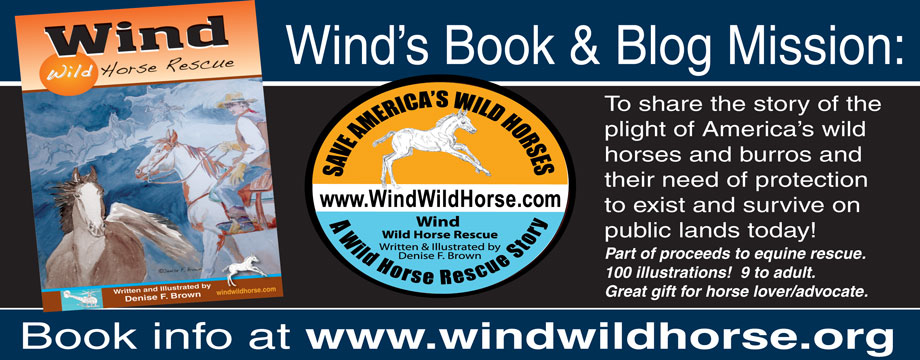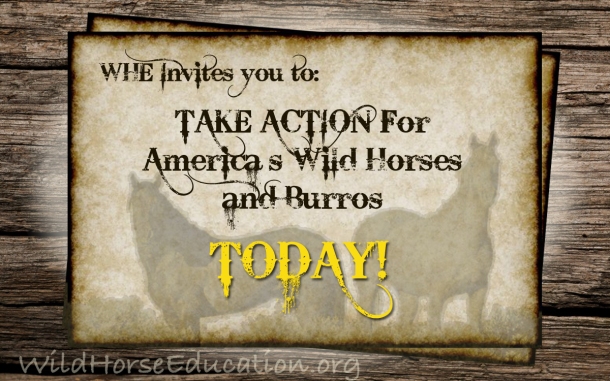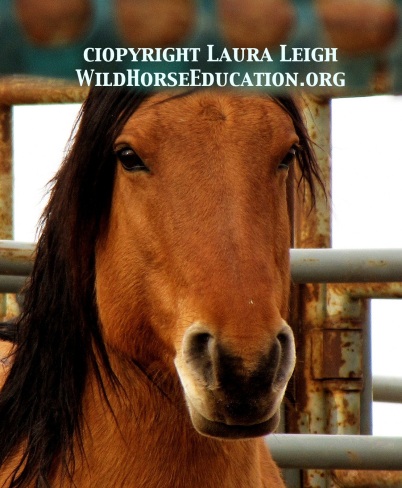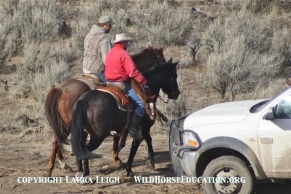Invitation to Action
WHE Take ACTION
WHE (Wild Horse Education) invites you to participate in action items to save the wild horses and burros. We will post actions on our website and Facebook page. When we ask you to do a written response to an individual or agency, we will give you the points to make and ask you to write your own response. Or we may ask you to “sign on” to an Action. Or we may request that you FAX or call your Representatives and will provide you the needed information. Each action will depend on the specific circumstances surrounding each issue.
WHE thought this would be a user-friendly way for you to get involved each week in saving our wild horses and burros. We hope you like the idea and will join in us and ACT to help our wild horses and burros! To make sure you get the weekly notice, go to our Facebook page https://www.facebook.com/WildHorseEducation Or go to our website http://wildhorseeducation.org/ and sign up to “follow”, if you have not already done so).
TWO Separate Actions are listed. Comments to the Utah Bible Springs roundup proposal and one on a humane handling policy. Please take both actions.
Utah’s wild horses need your voice
Comment on Utah proposed wild horse removal at Bible Springs (deadline May 30, 2014):
From BLM press release:
The EA analyzes a proposal to gather and remove excess wild horses and apply fertility control between two to four times over a 10-year period. The EA, including maps, is available on line at: http://www.blm.gov/ut/st/en/prog/wild_horse_and_burro.html or on the Environmental Notification Bulletin Board at: https://www.blm.gov/ut/enbb/index.php; search for project name “Bible.”
Written comments will be accepted by letter or email until May 30, 2014. Please note that the most useful comments are those that contain new technical or scientific information relevant to the proposed action. Comments should be as specific as possible. Comments which contain only opinions or preferences will not receive a formal response but may be considered in the BLM decision-making process. Please reference “Bible Spring Complex Wild Horse Gather Plan EA” when submitting comments.
Written comments may be mailed or emailed using the following:
Mail
BLM Cedar City Field Office
Attn: Cedar City Field Office Manager
176 E. DL Sargent Drive
Cedar City, UT 84721
Email
blm_ut_biblesprings@blm.gov
Before including an address, phone number, email address, or other personal identifying information in any comments, be aware that the entire comment—including personal identifying information—may be made publicly available at any time. Requests to withhold personal identifying information from public review can be submitted, but the BLM cannot guarantee that it will be able to do so. The BLM will not consider anonymous comments. All submissions from organizations and businesses, and from individuals identifying themselves as representatives or officials of organizations or businesses, will be available for public inspection in their entirety.
Wild Horse Education comments prepared by Laura Leigh are featured below to give you a template to create your own comments. Please personalize your comments to have them counted as “individual comments.” PLEASE take the time to write your comments and be counted! If you use email remember to put “Bible Spring Complex Wild Horse Gather Plan EA” in the subject line.
Comments ENVIRONMENTAL ASSESSMENT (EA) UT-C010-2014-0035
These comments are respectfully submitted with the intention of providing insight into areas overlooked with the above noted document.
The FONSI crafted begins with the introduction of basic premise material utilized to justify the vast majority of wild horse or burro removals notably 40 CFR 1508.27. For brevities sake we will simply note two sections of the CFR that have note been appropriately analyzed and provide potential avenues that should be explored in this document.
40 CFR 1508.27 (4) The degree to which the effects on the quality of the human environment are likely to be highly controversial.
This document simply notes the following in section 1.6: “Identification of issues for this assessment was accomplished by considering the resources that could be affected by implementation of one of the alternatives, as well as through involvement with the public and input from the BLM interdisciplinary team. Both Iron and Beaver County Commissioners have been in contact with the BLM requesting the removal of excess wild horses from private and public lands to within AML. The counties requested the use of fertility treatment methods on wild horses to reduce future population growth of wild horses. County resolutions have been passed to manage wild horse population with the counties at AML as directed by the WFRHBA. Public involvement consisted of posting the proposal on the Utah BLM Environmental Notification Bulletin Board on April 8, 2014.”
On April 10, 2014 BLM Utah held a phone conference with a handful of representatives from the wild horse advocacy. Several documents were promised to the individuals that attended this conference to provide appropriate ability for participation by those individuals. To date, after repeated phone calls and emails, the information has not been received. Until such time as that information is provided in the manner in which it was agreed upon appropriate participation of all stake holders is severely lacking in the proposed EA. The adequacy of meeting this CFR is absent in this document.
40 CFR 1508.27 (8) The degree to which the action may adversely affect districts, sites, highways, structures, or objects listed in or eligible for listing in the National Register of Historic Places or may cause loss or destruction of significant scientific, cultural, or historical resources.
This document fails to consider currently available information to adequately assess this portion of the CFR. This document notes historical decisions that pre-date currently available scientific record (The National Academy of Sciences, NAS, report being one document. Court orders to inhumane treatment being another). We will provide further clarification of this point as we comment to additional material contained in this draft FONSI).
Section 1.2 (Background)
A failure to use an appropriate interpretation of the NAS report becomes evident in this section. The NAS report can not be applied only to one portion of wild horse management (removals) and not another (setting of AML). If wild horse population are under counted then they were undercounted in setting of AML. Simply utilizing a flaw that was set forth in an antiquated and inaccurate land use plan is irresponsible. Appropriate amendments must be made before any wild horse removal EA is valid.
EA section 1.2 notes: Section 3 (b) (2) of the Wild Free-Roaming Horses and Burros Act (PL 92-195) as amended states that “Where the Secretary determines . . .that an overpopulation exists on a given area of the public lands and that action is necessary to remove excess animals, he shall immediately remove excess animals from the range so as to achieve appropriate management levels. The requirement for the authorized officer to remove excess animals immediately is also included in 43 CFR (Code of Federal Regulations) 4720.1.
However this fails to note the Department of Interior Manual on Management practices, specifically the section entitled “Integrity of Scientific and scholarly activities.” In decision making processes the Secretary must use scientific method that is “robust, of the highest quality and the result of as rigorous scientific and scholarly processes as can be achieved.” It is almost an obscenity to need to point out that a basic algebraic equation that has a variable applied to one side of an equation must be applied to another. IF an under counting was done during population surveys using the “better science” of today than an even more grotesque distortion was present setting Appropriate Management Levels (AML). The Secretary can not rely on previously set inaccurate AML to justify any removals if the DOI manual is followed in this instance. Only when AML reflects appropriate population counts can the Secretary adequately determine any “excess.” (In other words the NAS study can not be used piecemeal to justify removals but must also be used in setting AML).
Section 1.5 (Alternatives)
Again this section uses antiquated, pre-NAS report, decision records as a claim of “compliance” with CFR’s. The decision records noted do not reflect current “best practices” of scientific rigorous method. Simply listing the CFR’s does not mean that the EA is in compliance.
Section 1.6 (Identification of Issues)
This section notes the Iron County Commission correspondence yet fails to identify the issues at hand in their entire. The issues with Iron County began with threats against wild horses that were associated in support of a potentially violent protest in Clark County Nevada. They were further aggravated by repeated statements in the media from Iron County that the BLM failed to respond to appropriately. The creation FONSI appears to again aggravate the situation.
40 CFR 1508.27 (4) The degree to which the effects on the quality of the human environment are likely to be highly controversial.
BLM has failed to consider other interests in this matter. The April 10th meeting was not followed up on, was ignored and further inflamed this situation. This EA fails entirely in the regard to this CFR.
Furthermore the EA notes: As required by regulation [43 CFR 4740.1(b)], a public hearing would be held in Utah before July 1, 2014 and in subsequent years to discuss the use of helicopters and motorized vehicles in the management of Utah BLM’s wild horses and burros. Comments received at those public meetings would be considered and, if applicable, would be addressed in management actions, NEPA documents, decision documents using the most current direction from the National Wild Horse and Burro Program. As the meeting has not yet transpired, and is a requirement for removal operations, this EA is inadequate.
Section 2 is an analysis of proposed alternatives.
Alternative 1: Proposed Action –Gather and Removal Excess Wild Horses within the Bible Spring Complex and Implement Fertility Control. As this alternative is the actual action BLM will approve in the ROD we will limit comments to this alternative. In essence what is proposed will result in a “10 year” plan that results in multiple removals that will be governed by the subsequent ROD.
This section again utilizes an inaccurate definition of AML yet notes the NAS report citing that current populations are undercounted. AML’s were set in this area more than a decade ago when counting methods were even less accurate when than they are today. AML is then basically a flawed basis in determining excess. Every alternative proposed over the course of this “ten year plan,” that fails to take into account this major premise, is thereby invalid.
Any factor that is utilized in creating a removal plan that will exist for ten years without further analysis must include the notation that AML is flawed, and as further evaluation is made, AML will be adjusted accordingly.
Section 2 also notes the SOP’s in Appendix 5.
The SOPs have been proven inadequate in multiple court orders in the federal courts of the state of Nevada. Utilizing this standard of operation is irresponsible given this significant fact. Utilizing these legal precedents must be a factor in analyzing the SOPs at any removal operation for the analysis to be complete.
We have attached a form outlining additional material to be considered in formulating SOPs based in the most comprehensive data base to date of BLM practices of the last four years. The attachment can be accessed at this link: http://wildhorseeducation.files.wordpress.com/2014/03/action_wip_humanel.pdf
Under the consideration for removal of livestock this notation is made “The elimination of livestock grazing in an area would require an amendment to the Pinyon MFP. Such changes to livestock grazing cannot be made through a wild horse gather decision.” However the lack of action in amending those plans prior to the decision on a wild horse removal could invalidate the process of removing wild horses.
AUM distribution is based on flawed calculations that fail to utilize simple tools such as slope grids. AUM distribution is a valid component of determining “excess wild horses,” and if flawed, invalidates that determination.
The section that rules out “Upper Limit of AML” notes “A post-gather population size at the upper level of the AML range would result in the AML being exceeded the next foaling season.” This would only be a valid statement if AML were based on accurate data. Since AML is not the product of an accurate equation the justification to discount removals to upper limit of AML are invalid.
It would be highly prudent to utilize the flawed “upper limit” AML as a temporary figure to mitigate any damages to the historic value, public interest, etc noted in the CFR’s until AML is actually a scientifically rigorous determination.
Issues of public observation are vaguely noted and an arbitrary discretion exists. We urge you to formulate an adequate media protocol that ensures access to observe and document operations and conditions of wild horses is provided. This proposed plan includes no such document and is inadequate.
Thank you for the opportunity to comment,
Laura Leigh submitting comments as President and Founder of Wild Horse Education
wildhorseeducation@gmail.com
Reno, Nevada
ACTION ITEM WEEK OF MARCH 30th
ONGOING
So far Wild Horse Education has collected over 2,400 Pledges from individuals committed to working toward gaining a humane care policy for the BLM wild horse and burro program. The “Pledge” for Humane care has been added to our six point “Challenge to the BLM” for programmatic changes to the entire program.
We are completing work on our first action item under the challenge. The action item is a mass mailing that demands that a POLICY be in effect for humane handling prior to any further removals of wild horses and burros from the range. The goal of the challenge is to create a sane management plan that keeps wild horses on the range and is a focus of our “Keep Them In the Wild” program. However we will see removals begin again this year in several areas that the BLM is monitoring for “drought.” We hope to have resources to again collect data to present that has the welfare of wild horses in mind as we did last year at the Snowstorm HMA (part of the Owyhee Complex) where we challenged a removal decision based on site specific data, and the operation was cancelled.
However the need to push hard for an actual humane care policy program wide has never been greater. There will be removals scheduled and we must have a humane policy in place before one more wild horse or burro is removed from public land.
Wild Horse Education has the most inclusive, consecutive, library of documentation from range through holding than exists anywhere in recent years. Based on that documentation and our litigation that has gained court orders against BLM conduct at roundups more than demonstrates a need for the adoption of a specific uniform policy for handling of wild horses and burros.
Please join us in this action. Wild Horse Education will do a mass mailing to key representatives in Congress and the BLM. But we ask that YOU take action. We must be the voice for our wild horses and burros!
Each item in the 6 point challenge will have a similar action item request. All action items will then be combined and WHE will do a mass mailing of an entire packet that will include a CD of documentation.
Please take one of these actions for a Humane Handling Policy TODAY:
1. Download the pdf below and email or fax to your representatives. Please email or fax to Sally Jewell the head of the Department of Interior, Joan Guilfoyle the current BLM Wild Horse and Burro Division Chief, Neil Kornze the acting Director of the BLM and Edwin Roberson Assistant Director of Renewable Resources (wild horses and burros.)
2. Write your own letter to the above mentioned individuals.
If you do not have time to send your own letters of download our pdf to email or FAX please add your name to our lists.
3. Add your name to the Pledge here: http://wildhorseeducation.org/whe-pledge/
4. Add your name to the 6 point challenge to the BLM here: http://wildhorseeducation.org/2014/03/18/whe-challenges-blm/
Emails and addresses:
Neil Kornze, BLM acting Director, email: director@blm.gov Fax: 202-208-5242
Edwin Roberson, Assistant Director, Renewable Resources and Planning (includes wild horses and burros) Fax: 202-208-5010 E-mail: eroberso@blm.gov
Joan Guilfoyle, BLM Wild Horse and Burro Division Chief, email: jguilfoy@blm.gov
Sally Jewell, Secretary of the Interior, Phone: (202) 208-3100 E-Mail: feedback@ios.doi.gov
Find your Representatives HERE:
House: http://www.house.gov/representatives/find/
Senate: http://www.senate.gov/general/contact_information/senators_cfm.cfm
PDF to Download and FAX or write your own letter
http://wildhorseeducation.org/invitation-to-action/





